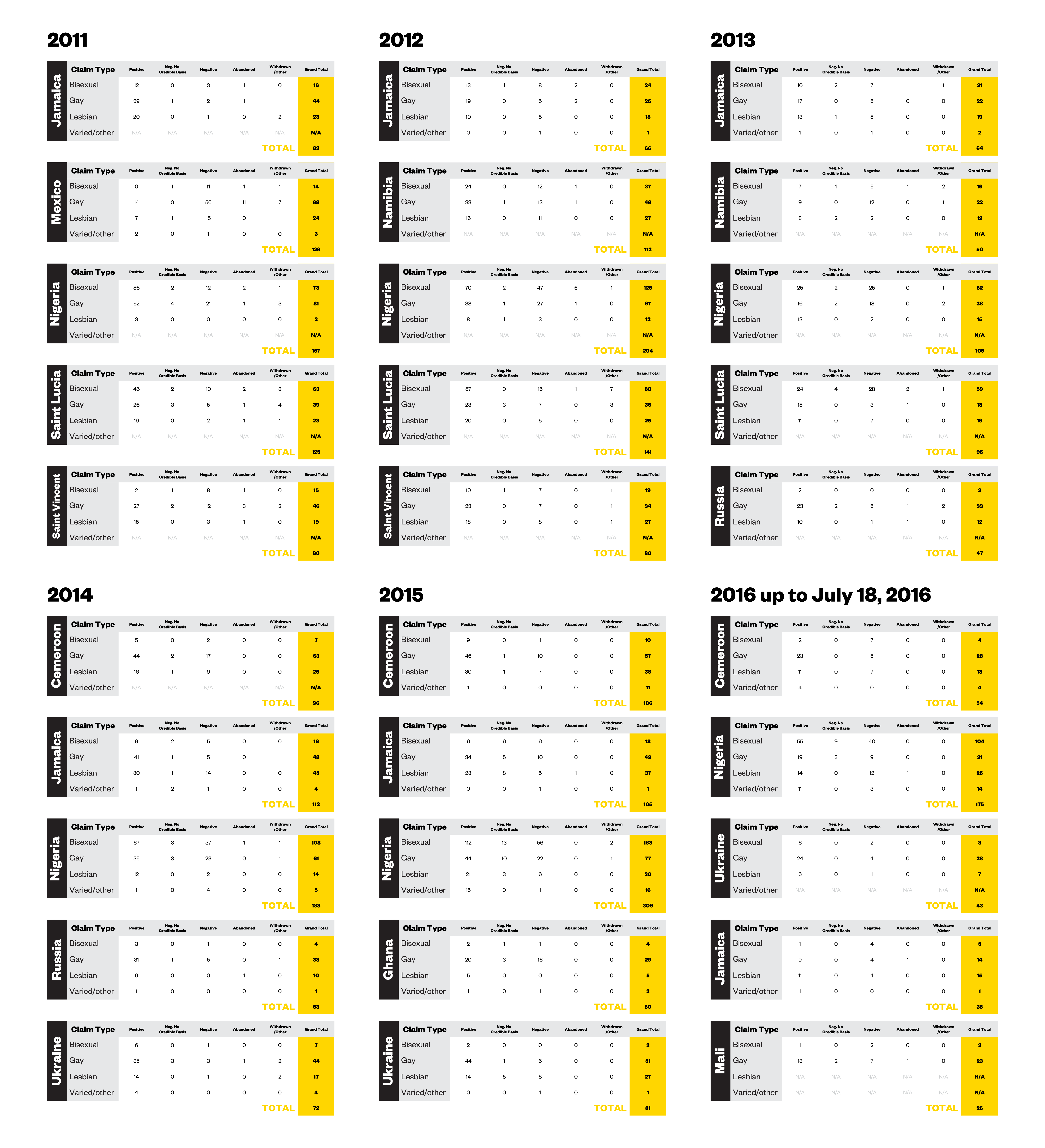A gay couple holds hands during a mass wedding in Mexico City March 21, 2014. According to the organizers, fifty-eight same-sex couples married on Friday to commemorate the 4th anniversary of the legalization of same-sex marriages in Mexico City, the first jurisdiction in Latin America to do so. REUTERS/Edgard Garrido (MEXICO - Tags: SOCIETY) - RTR3I3NY
As Canada moves to relax the impossibly high standards imposed on LGTBQ refugee claimants seeking entry into the country, new numbers show just how difficult it has been for people fleeing persecution and homophobic, state-sanctioned violence.Around 64 percent of refugee claims — 4,179 out of 6,563 — where sexual orientation was listed as the basis were accepted into Canada between 2011 and mid-2016, according to numbers obtained by VICE News. Only 222 claims — 3 percent — were rejected because they were deemed to have no credible basis.But a significant number of LGBTQ refugee claimants from countries where same sex relationships are punishable by law are being turned away from Canada, with several of those countries regularly showing up in the top 5 places from which Canada receives such claims.That’s why a new set of guidelines for refugee claims involving sexual orientation that took effect this week is being praised as “a step in the right direction.”In some cases, claimants haven’t documented their relationship to avoid the risk of the evidence falling into the wrong hands. In others, they’ve never even engaged in a homosexual relationship for fear of getting caught.The guidelines, which lay out how decision makers should assess evidence and the credibility of claims in cases involving sexual orientation, gender identity and expression, acknowledge that in some cases, the person’s testimony might be the only evidence of their claim — until now, LGBTQ refugee claimants have had no choice but to rely on an IRB member’s discretion.
Advertisement
In the first half of 2016, for example, 64 sexual orientation-based refugee claims from Nigeria — where the country’s same sex marriage prohibition law has fuelled anti-LGBT violence, arrests, and torture — were rejected. Twelve of these were found to have no credible basis, meaning the decision maker didn’t find the evidence presented by the claimant credible or trustworthy. Nigeria consistently appeared among the top five countries to produce claimants.The Immigration and Refugee Board (IRB) stresses that claims may be rejected because of factors other than the sexual orientation grounds. They also note that in some cases, there’s more than one claim type, and if a claimant chooses to pursue another avenue as a refugee, the IRB doesn’t track that.In a system that gives little credence to claimant’s own testimony, LGBTQ refugees have often been expected to offer hard proof of their identities — photos and text messages that show they’ve been in romantic relationships, for example, or witness testimony from friends or family, who may be in the dark because the claimant has been living in the closet out of fear.LGBTQ refugees have often been expected to offer hard proof of their identities
Advertisement
Refugee claims based on sexual orientation, gender identity and expression are challenging and “in some ways, they’re very different from other types of claimants,” said Janet Dench of the Canadian Council for Refugees.Religious persecution is different from persecution based on sexual orientation, for example, because in most cases, abuses against religious groups in a particular country are documented and “known to the world,” she explained.“Sexual orientation and gender identity is different is for the most part is something that’s not obvious to people, especially when you’re being persecuted on that basis,” she said. “You keep it hidden.”The new guidelines acknowledge the possibility that the person may have been open about their sexuality and may not “have anything other than their own testimony to identify them.”Decision makers are also encouraged not to rely on stereotypes and assumptions to assess credibility, like that someone should have “feminized or masculinized appearances of mannerisms” because of their sexual orientation, that they don’t practice their religion, or that they’ve never had heterosexual sexual experiences, to name a few of the 10 the government has listed, which have come up in past cases.“You keep it hidden.”
Advertisement
“There’s reasons for that, especially when individuals are mistrustful of the state, and don’t feel as free to provide testimony on very sensitive subjects,” said IRB spokesperson Anna Pape.The new guidelines also note how trauma and mental health issues “stemming from a history of social isolation, mistreatment and lack of social support in their countries of reference” could impact an LGBTQ refugee claimant’s ability to adequately make their case before the IRB.“Every claim is assessed on its own merits, and testimony will vary as environment varies from one country to another as well,” said Pape. “Sometimes people are traumatized, but sometimes people are more able to discuss their circumstances because they haven’t experienced huge trauma even though their freedoms have obviously been impacted.”As of last summer, same-sex sexual acts are illegal in 72 countries, according to a report by the International Lesbian, Gay, Bisexual, Trans and Intersection Association. In 13 countries, they’re punishable by death.VICE News obtained data on the outcomes of refugee claims based on sexual orientation from to 2011 to July 2016, broken down by country of origin. Here are the top five countries to produce such claims for each year.“Sometimes people are traumatized”
